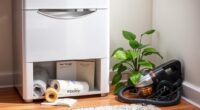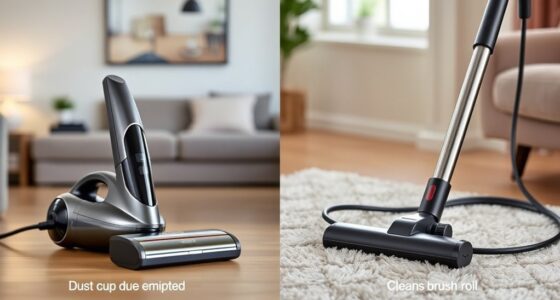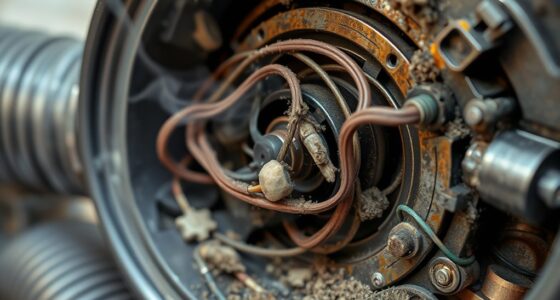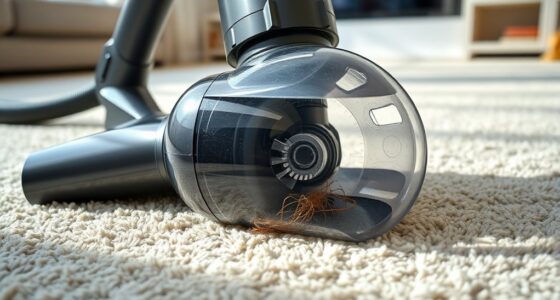You should service your vacuum every 6-12 months for residential models, annually for central vacuums, and every 3-6 months for commercial ones based on usage. Regular maintenance helps extend your vacuum’s lifespan and guarantees peak performance by maintaining suction power and airflow efficiency. Look for signs like reduced suction or unusual noises, which indicate that it’s time for servicing. Keep going to discover essential maintenance tips and common vacuum problems you might encounter.
Key Takeaways
- Service residential vacuums every 6-12 months to ensure optimal performance and longevity.
- Central vacuums should receive annual servicing to maintain efficiency and prevent issues.
- Commercial vacuums require checks every 3-6 months, depending on usage intensity.
- Replace vacuum filters every 3-6 months to improve suction power and airflow efficiency.
- Regularly inspect belts and brushes every three months to prevent mechanical problems and ensure effective cleaning.
Recommended Servicing Frequency for Different Types of Vacuums

When you want to keep your vacuum running smoothly, understanding how often to service it’s essential. For most residential vacuums, aim to service your vacuum every 6-12 months to guarantee peak performance and longevity.
To ensure optimal performance, service your residential vacuum every 6-12 months for longevity and efficiency.
Central vacuums, on the other hand, require annual servicing to prevent dust and debris buildup that can hinder efficiency.
If you’re using commercial vacuums, you’ll likely need more frequent checks, ideally every 3-6 months, depending on usage.
Additionally, don’t forget to replace your vacuum filters every 3-6 months to maintain airflow and suction power. Regular checks of belts and brushes every three months can help identify wear, preventing more serious mechanical issues down the line. It’s also important to consider the best HEPA filter vacuums, as they provide superior filtration and can significantly improve indoor air quality.
Importance of Regular Maintenance for Vacuum Performance
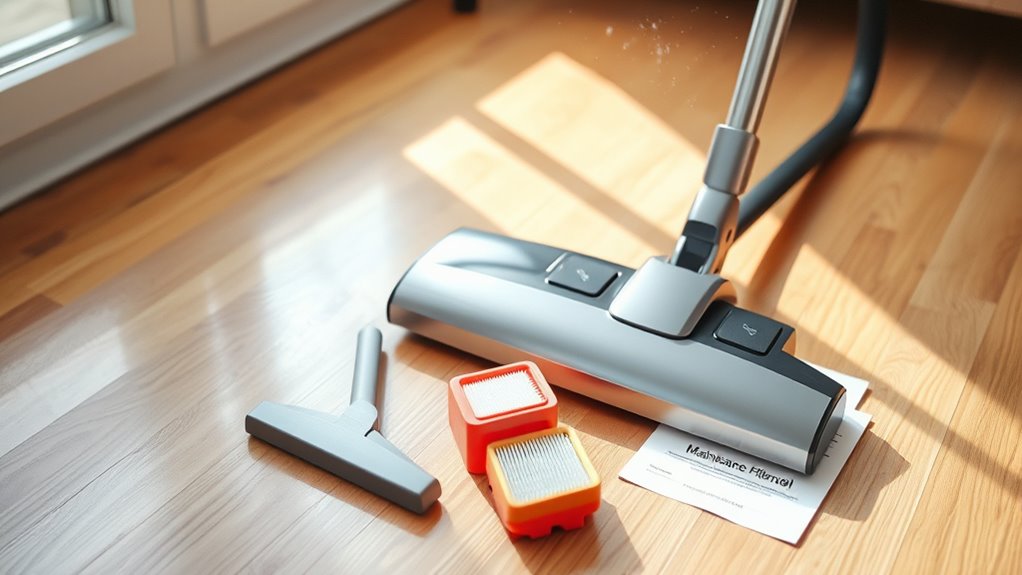
Regular maintenance is key to keeping your vacuum running at its best, ensuring it cleans efficiently and maintains good air quality. By taking care of your vacuum, you’ll not only extend its lifespan but also enhance your overall cleaning experience. When you stay on top of servicing, you can prevent issues before they arise and enjoy a cleaner home. Furthermore, maintaining suction power is essential for optimal performance, as it directly impacts how effectively your vacuum cleans various surfaces. Regularly cleaning the filters can significantly improve airflow and efficiency.
Enhanced Cleaning Efficiency
To keep your vacuum performing at its best, it’s essential to prioritize regular maintenance. By cleaning or replacing filters every 3-6 months, you’ll greatly improve airflow and suction power, enhancing cleaning efficiency. Additionally, inspecting belts and brush rollers quarterly helps prevent mechanical issues that can hinder performance. Investing in a model with strong suction power is also crucial for maintaining optimal cleaning results. Regularly servicing your vacuum can lead to improved longevity and a better overall user experience.
Here’s a quick guide to boost your vacuum’s effectiveness:
| Maintenance Task | Frequency |
|---|---|
| Clean or Replace Filters | Every 3-6 months |
| Inspect Belts and Brush Rollers | Quarterly |
| Full Vacuum Service | Every 6-12 months |
Address early signs of trouble, like reduced suction or unusual noises, to prevent costly repairs. Regular maintenance guarantees your vacuum remains efficient and effective in tackling dirt and allergens.
Prolonged Equipment Lifespan
Maintaining your vacuum not only boosts its cleaning efficiency but also plays an essential role in prolonging its lifespan. Regular maintenance, typically every 6-12 months for residential vacuums, helps prevent performance issues like reduced suction power due to blockages or mechanical failures.
By checking and replacing filters every 3-6 months, you enhance both efficiency and motor longevity. Additionally, inspections of belts and brush rollers every few months catch wear and tear early, avoiding further damage.
Sticking to a maintenance schedule not only safeguards your vacuum’s performance but also protects your warranty coverage, as many manufacturers require consistent servicing to uphold claims. Investing in maintenance can be compared to maintaining best home security systems to ensure optimal performance over time.
Invest in maintenance to guarantee your vacuum serves you well for years to come.
Improved Air Quality
When you take the time to service your vacuum, you’re not just ensuring its efficiency—you’re also enhancing the air quality in your home.
Regular vacuum maintenance, including cleaning and replacing filters every 3-6 months, drastically reduces dust and allergens. A well-maintained vacuum maintains ideal airflow, preventing harmful particles from recirculating into the air.
If you neglect servicing your vacuum, you risk reduced suction power, which can lead to increased dust release and poorer air quality, ultimately impacting your respiratory health.
Clogged or dirty filters can’t effectively trap fine particles, contributing to allergen buildup.
Signs Your Vacuum Needs Servicing
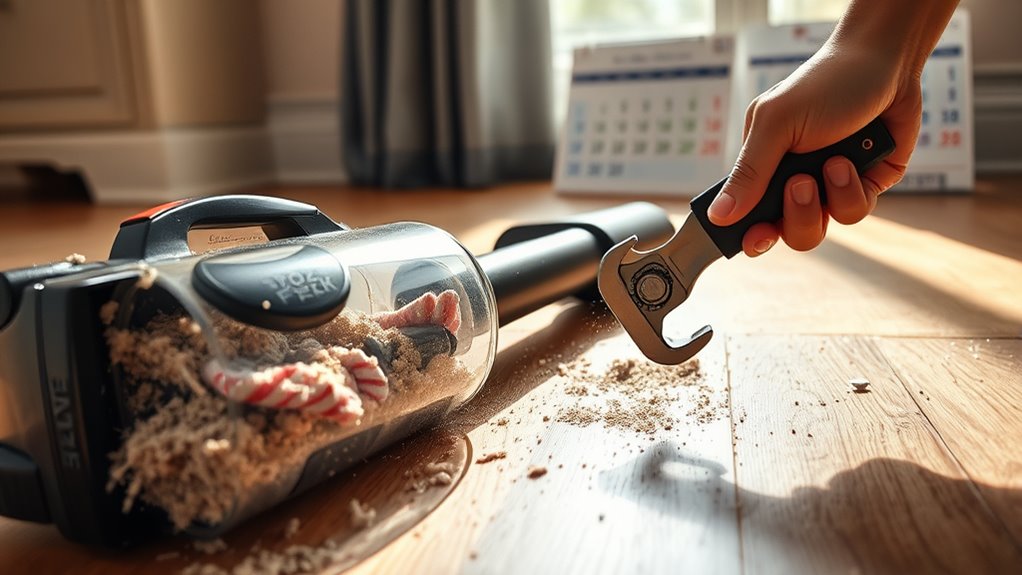
How can you tell if your vacuum needs servicing? Look out for these signs your vacuum needs servicing:
Look out for signs like reduced suction or unusual noises to determine if your vacuum needs servicing.
- Reduced suction power: This often indicates blockages or dirty filters.
- Unusual noises: Rattling or grinding sounds suggest mechanical issues that can’t be ignored.
- Burning smells: If you detect strange odors, especially burnt ones, your vacuum may have belt problems or be overheating.
- Frequent clogging: If you’re constantly dealing with clogs or find debris left behind, it’s time to check the filters or hoses.
Ignoring these signs can lead to more significant problems.
If you notice any of these issues, don’t hesitate to schedule a professional inspection to keep your vacuum running smoothly.
Essential Maintenance Tips for Vacuum Cleaners
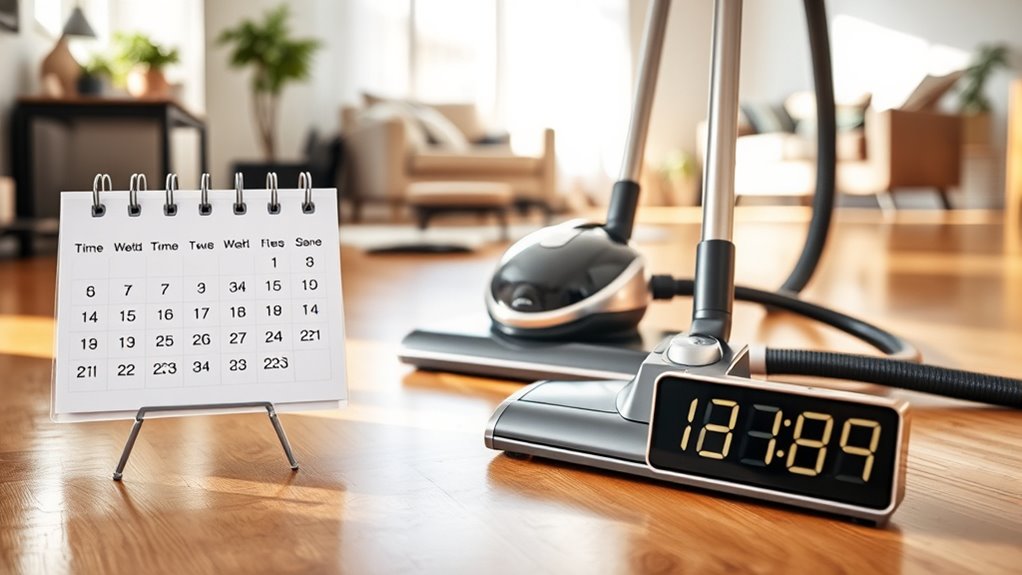
To keep your vacuum running smoothly, you need to regularly check the filters and replace them as needed.
Make it a habit to inspect the brush roll for any tangled hair or debris to guarantee peak cleaning performance.
Finally, monitor the suction power; if it starts to wane, it’s time to address potential issues.
Regular Filter Replacement
Regularly replacing your vacuum’s filters is essential for maintaining its efficiency and performance. To guarantee peak airflow and prevent clogged filters, follow these tips:
- Replace filters every 3-6 months to maintain suction efficiency.
- Increase frequency for homes with pets or high dust levels.
- Consult the manufacturer’s guidelines for specific filter replacement recommendations.
- Clean reusable filters as instructed to prolong their lifespan.
Neglecting regular filter replacement can lead to decreased vacuum performance, overheating, and potential motor damage.
By prioritizing filter maintenance, you can keep your vacuum running smoothly and effectively, guaranteeing a clean home environment.
Stay proactive with your vacuum maintenance, and you’ll enjoy the benefits of a well-functioning appliance.
Inspect Brush Roll
Maintaining your vacuum’s filters is just one part of keeping it in top shape; the brush roll also plays an essential role in its performance.
To guarantee peak functionality, regularly inspect the brush roll for hair and debris buildup, as this can impede its rotation. You should clean or replace the brush roll at least once a month, especially if you have pets or high foot traffic.
Make sure it’s free from tangles and check for any signs of wear and replace damaged parts promptly. Proper maintenance not only enhances your vacuum’s cleaning capabilities but also prevents overheating, prolonging its lifespan.
Monitor Suction Power
While vacuuming, you might notice a decline in suction power, which can signal blockages in the filters, hose, or dust container that need your attention.
To keep your vacuum performing well, it’s crucial to monitor suction power regularly. Here are some key maintenance tips:
- Replace the bag when it’s two-thirds full to prevent motor strain.
- Clean or replace filters every 3-6 months for ideal airflow.
- Inspect the brush roll for hair and debris, ensuring effective cleaning.
- Check hoses and attachments for wear or damage; timely vacuum repairs can make a difference.
Understanding Vacuum Parts and Their Maintenance
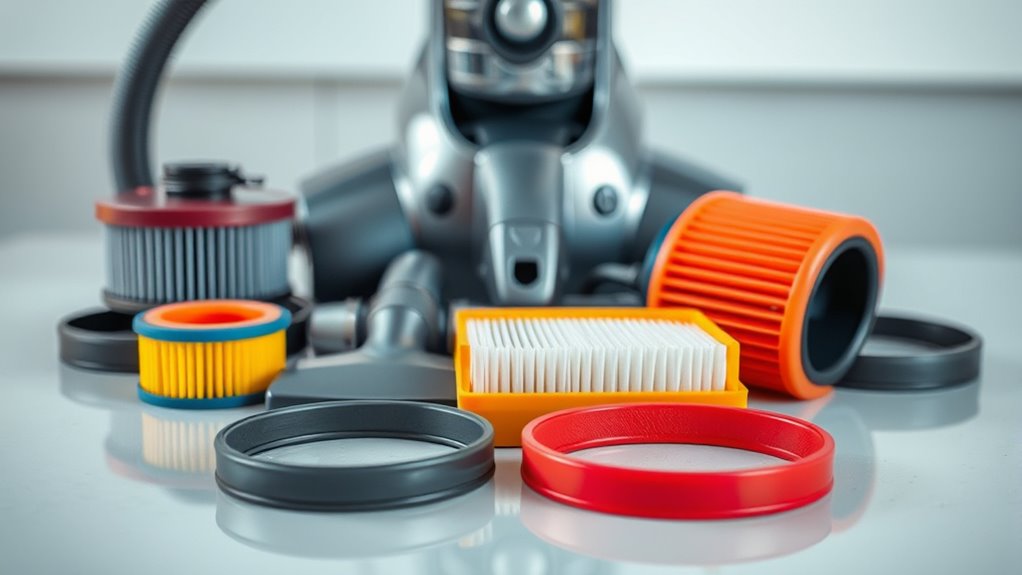
A well-functioning vacuum relies on several key parts that require your attention for peak performance.
Regular maintenance and repair of vacuum parts, like filters, is vital. Clean or replace your filters every 3-6 months according to your vacuum needs to maintain proper airflow and improve air quality.
Don’t forget to inspect the brush roll area regularly; hair and debris buildup can hinder cleaning performance. Check hoses and attachments for clogs before each use to prevent overheating or reduced suction.
Additionally, inspect belts for wear or damage; replacing them as needed is essential for effective debris pickup. Regularly servicing your vacuum can help extend its lifespan, similar to how Dyson vacuums are designed for durability and long-term use.
Professional Vacuum Repair Services: What to Look For
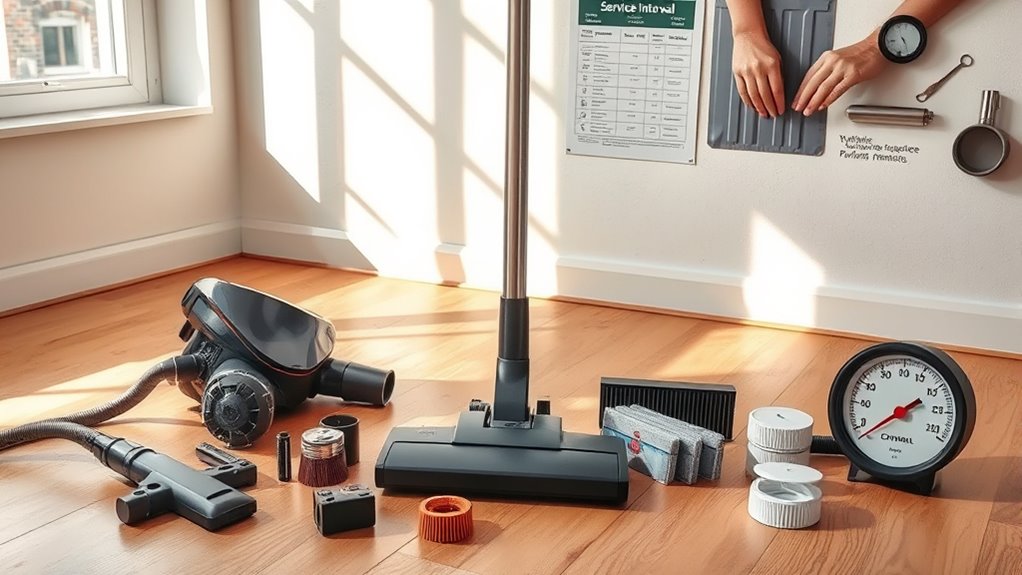
When your vacuum starts showing signs of wear or inefficiency, finding the right professional repair service can make all the difference.
When your vacuum shows wear, choosing the right repair service is essential for restoring its efficiency.
To guarantee you get the best service, look for the following:
- Qualified technicians with experience in your specific vacuum brand
- An authorized dealer that has access to the latest parts and guidelines
- Use of genuine replacement parts instead of generic alternatives for better performance
- Warranty coverage on repairs, providing peace of mind for quality assurance
- Ensure the service provider understands the importance of filtration systems in maintaining your vacuum’s efficiency and performance.
Common Vacuum Problems and DIY Solutions
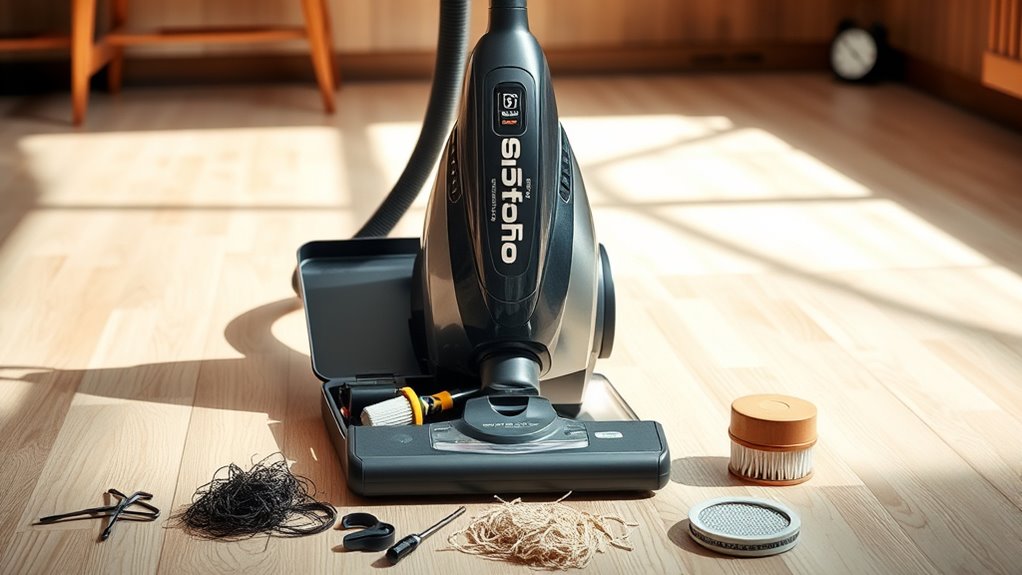
Vacuum cleaners can encounter a variety of issues that disrupt their performance, but many of these problems can be tackled with a few simple DIY solutions.
Common issues like reduced suction power often stem from clogged filters, a full dustbin, or blockages in the hose. Regular vacuum maintenance includes cleaning or replacing these components.
If you hear unusual noises, inspect the brush roll and belt for damage, replacing them if necessary.
Overheating can signal a full dust container or blocked hoses; let your vacuum cool down before troubleshooting.
Frequent clogging can be avoided by checking for blockages regularly.
Finally, if you notice wear on vacuum cleaner parts like belts or brushes, replace them promptly to guarantee peak cleaning performance.
The Benefits of Timely Vacuum Maintenance
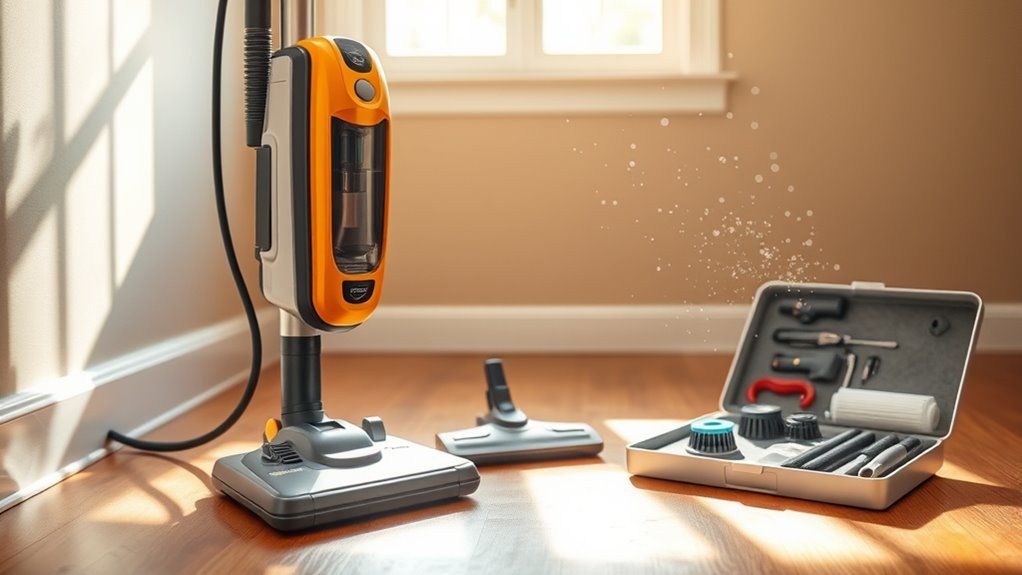
Maintaining your vacuum regularly offers numerous benefits that can enhance its performance and longevity.
By committing to timely vacuum maintenance, you can enjoy:
- Peak performance: Regular servicing prevents loss of suction and unusual noises.
- Improved indoor air quality: Routine checks help reduce dust and allergens, essential for allergy sufferers and pet owners.
- Extended lifespan: Proper care can help your vacuum last 5-8 years, avoiding costly repairs or replacements.
- Warranty protection: Many manufacturers require regular servicing to uphold warranty conditions.
Frequently Asked Questions
How Often Should a Vacuum Be Serviced?
You should service your vacuum every 6 to 12 months to keep it running smoothly.
If you’ve got a central vacuum, aim for annual servicing to extend its life.
For commercial vacuums, check them every 3 to 6 months, especially if they see heavy use.
Watch for signs like loss of suction or unusual noises—these could mean it’s time for an earlier service.
Regular maintenance, including filter changes, is key to peak performance.
Do Vacuum Cleaners Need Servicing?
Yes, vacuum cleaners do need servicing to perform at their best.
You should regularly check for signs like reduced suction, unusual noises, or overheating. When you replace filters every few months, it helps maintain airflow and prevents clogging.
What Is the Average Life of a Vacuum Cleaner?
Think of your vacuum cleaner as a loyal steed, tirelessly battling dust bunnies and pet hair.
On average, a quality vacuum lasts between 5 to 8 years, depending on its model and how well you care for it. If you’ve got a busy household or furry friends, it might wear out faster.
Regular maintenance can help extend its life, ensuring your trusty companion stays by your side a little longer in the fight against mess.
How Often Should You Service a Dyson Vacuum?
You should service your Dyson vacuum approximately every 12 months to keep it running smoothly.
In between those annual check-ups, make sure you clean or replace the filters every 3-6 months.
Regularly inspect the brush bar and belt for wear or blockages to avoid mechanical issues.
If you notice reduced suction, unusual noises, or overheating, it’s time for a service.
Following these steps will help extend your vacuum’s lifespan and effectiveness.
Conclusion
To sum up, keeping your vacuum in top shape isn’t just about cleaning; it’s about enhancing your home’s air quality and efficiency. By following expert recommendations on servicing frequency, you’ll guarantee peak performance and longevity. Look out for signs your vacuum needs help, and don’t shy away from DIY maintenance. Remember, a well-maintained vacuum not only saves you money in the long run but also provides a cleaner, healthier living environment for you and your family.

